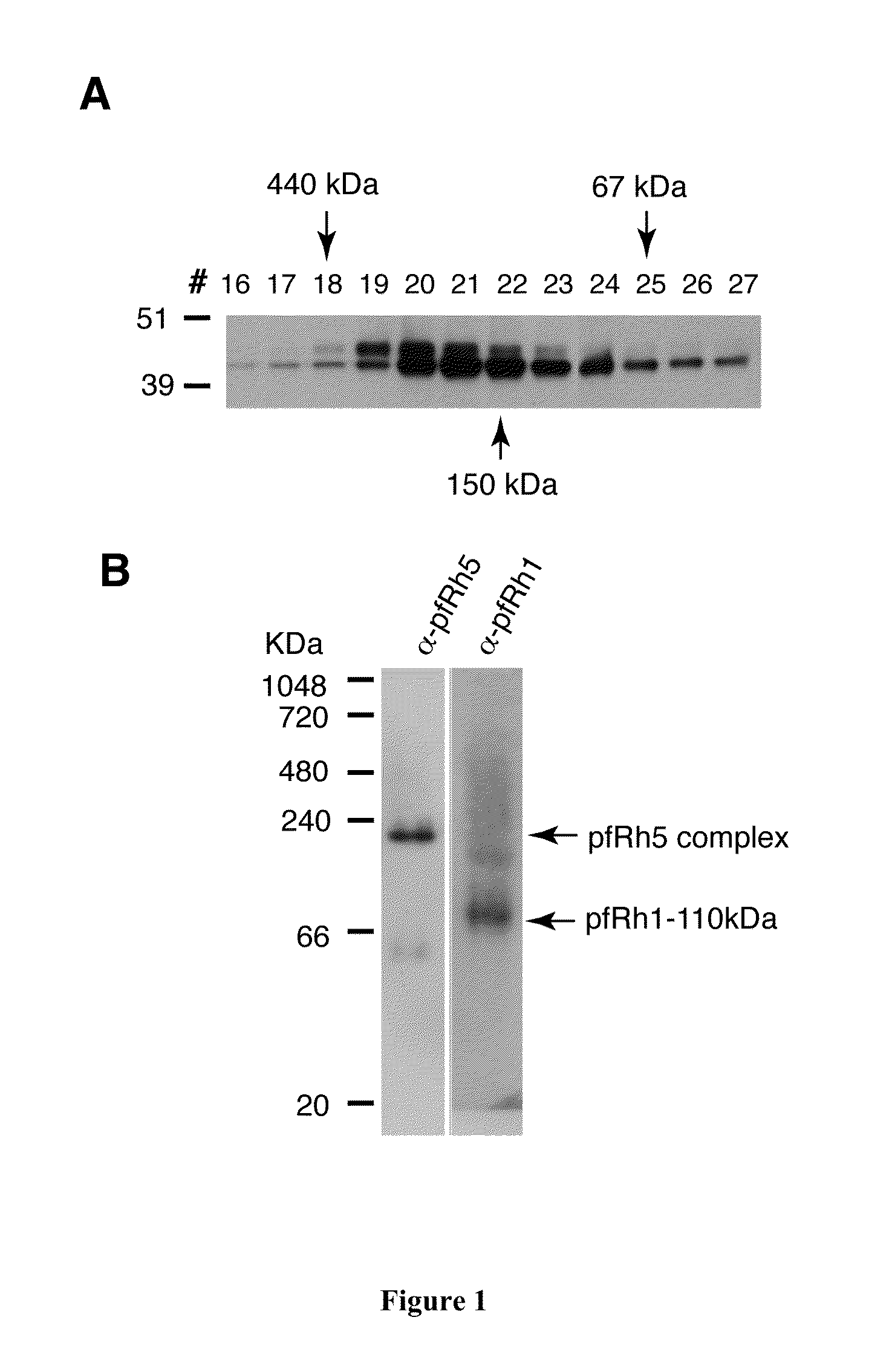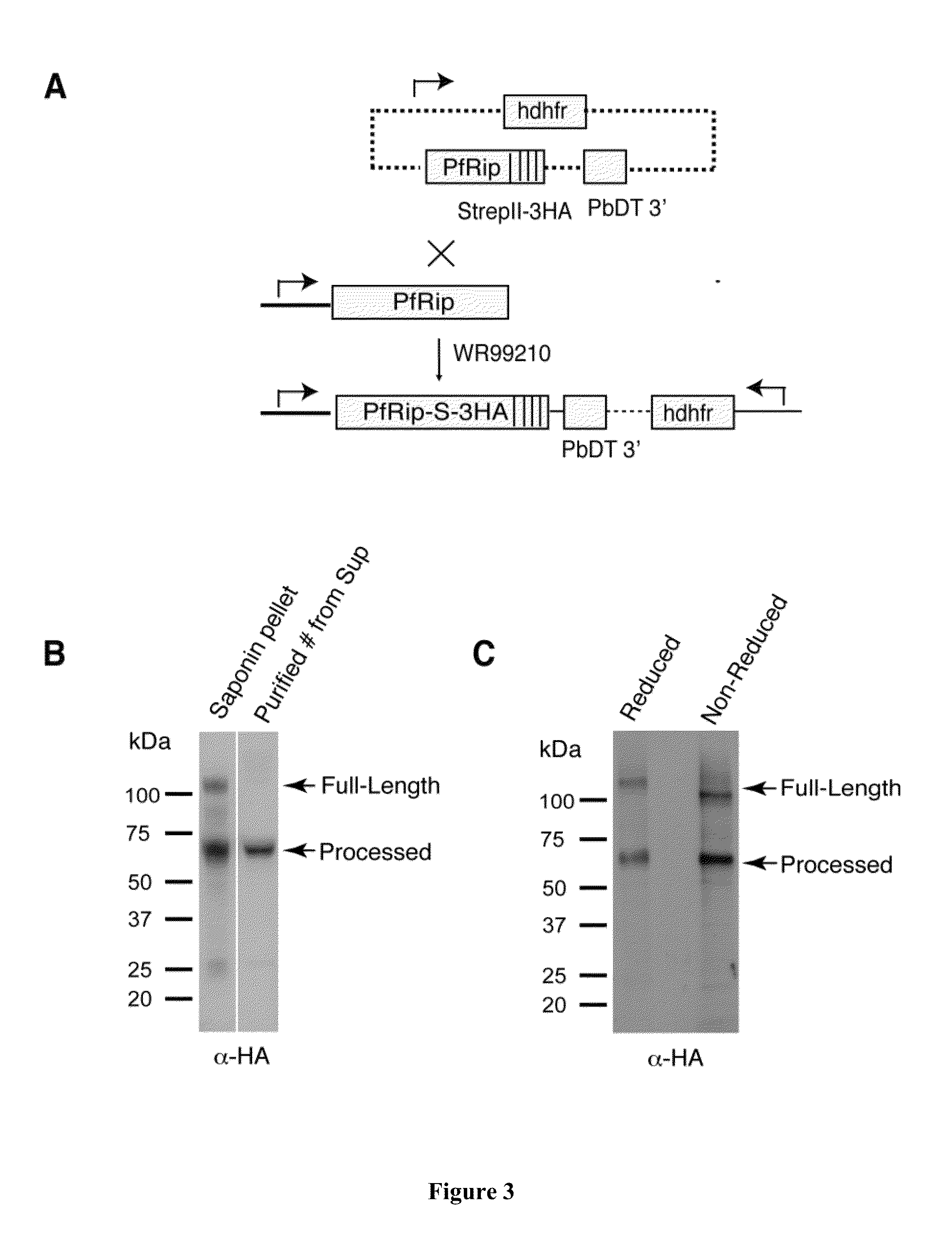Treatment and prevention of malaria
a technology of plasmodium and plasmodium spp., which is applied in the field of malaria treatment and prevention, can solve the problems of increasing the risk of children's death from malaria, increasing the number of visitors to endemic areas, and the dna vaccine has shown poor antibody induction effect in humans
- Summary
- Abstract
- Description
- Claims
- Application Information
AI Technical Summary
Benefits of technology
Problems solved by technology
Method used
Image
Examples
example 1
Identification of pfRip as Rh5 Complex Partner
[0292]Processed 45 kDa pfRh5 from parasite culture supernatant was purified by ion-exchange chromatography. Analysis of pfRH5 by size exclusion chromatography on a Superdex 200 analytical column demonstrated that pfRh5 was eluted as an ˜150-200 kDa species (FIG. 1A). Blue native gel electrophoresis confirmed that pfRh5 migrates on a gel as an ˜150-200 kDa species (FIG. 1B).
[0293]To determine whether pfRh5 is in complex with other molecules or if it forms a homo-oligomer, the protein was incubated with pfRh5 antibody and analysed by size exclusion chromatography. A 300 μl pfRh5-containing fraction isolated from culture supernatant was loaded onto a Superdex 200 analytical column and eluted with PBS (FIG. 2A). An identical 300 μl sample was pre-incubated with 25 μg monoclonal pfRh5 antibody at room temperature for 15 minutes and then on ice for 2 hours before loading onto being loaded onto a Superdex 200 analytical column and eluted with P...
example 2
Shedding of pfRip into Culture Supernatant
[0295]A single Strep-tag and triple Haemaglutinin (HA) tag were added to the C-terminus of pfRip by 3′-single homologous cross-over recombination (FIG. 3A). Immunoblotting of saponin pellet and HA-tagged protein purified from culture supernatant of pfRipHA line with anti-HA antibody demonstrated that PfRip was processed and shed to culture supernatant (FIG. 3B). PfRipHA was also analysed by SDS-PAGE under reducing and non-reducing conditions and transferred to nitrocellulose membrane. Immunobloting with anti-HA antibody showed that the processed C-terminal fragment migrates similarly under both reducing and non-reducing condition, suggesting that N-terminal and C-terminal of pfRip is not linked by any disulphide bond after processing (FIG. 3C).
example 3
Immunoprecipitation of pfRip
[0296]Culture supernatants from both wt 3D7 and 3D7-pfRipHA parasite lines were immunoprecipitated with anti-HA-Sepharose bead. Bound materials were separated by SDS-PAGE, transferred to nitrocellulose membrane to probe for pfRh5 using monoclonal anti-pfRh5 antibody (clone 2F1). Detection of pfRh5 in the bound material only from 3D7-pfRipHA line indicated that pfRh5 was specifically co-immunoprecipitated with pfRipHA (FIG. 4A).
[0297]Culture supernatants from both wt 3D7 and 3D7-pfRipHA parasite lines were immunoprecipitated with monoclonal anti-pfRh5 antibody coupled to Mini-bead, and culture supernatant of 3D7-pfRipHA parasites was incubated with just Mini-bead as additional control. Bound materials were separated by SDS-PAGE, transferred to nitrocellulose membrane to probe for pfRipHA using anti-HA antibody (FIG. 4B). Detection of pfRipHA in the bound material only from 3D7-pfRipHA parasite line immunoprecipitated with anti-pfRh5-Mini-bead indicated tha...
PUM
| Property | Measurement | Unit |
|---|---|---|
| Fraction | aaaaa | aaaaa |
| Fraction | aaaaa | aaaaa |
| Immunogenicity | aaaaa | aaaaa |
Abstract
Description
Claims
Application Information
 Login to View More
Login to View More - R&D
- Intellectual Property
- Life Sciences
- Materials
- Tech Scout
- Unparalleled Data Quality
- Higher Quality Content
- 60% Fewer Hallucinations
Browse by: Latest US Patents, China's latest patents, Technical Efficacy Thesaurus, Application Domain, Technology Topic, Popular Technical Reports.
© 2025 PatSnap. All rights reserved.Legal|Privacy policy|Modern Slavery Act Transparency Statement|Sitemap|About US| Contact US: help@patsnap.com



